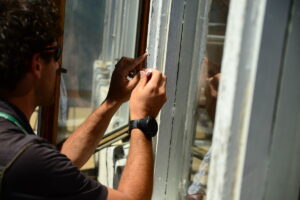Lead paint testing is never entirely a one-and-done situation. Knowing when to get a retest can save you from violations, protect your tenants, and keep you compliant with local laws.
Here’s everything you need to know about needing a lead paint inspection in NYC again, what triggers retesting requirements, and how to stay on the right side of some pretty serious regulations.
Local Law 31 and Retesting
If you already tested at the old 1.0 mg/cm² standard, do you need to retest at the new 0.5 mg/cm² level?
The short answer: no, you’re not required to retest at 0.5 mg/cm² to be compliant if you have a copy of the XRF report.
However, if you want to apply for a lead exemption, you’ll be required to retest at the lower threshold.
This is good news for property owners who were proactive and got testing done early. However, it also means that if you plan to seek an exemption, you’ll need to undergo current testing at the 0.5 mg/cm² action level.
When Is Retesting Legally Required?
1. After Abatement or Remediation
If you’ve had lead paint abated, encapsulated, or enclosed, you need post-abatement clearance testing to verify that the work was done properly and that lead levels are now safe. This is required before your property is ready for living.
2. When a Child Under Six Moves In
If a unit is inhabited or frequented by a child under the age of six, testing must be completed within one year of the child moving in, if it hasn’t been done already. This applies even if you’ve previously tested the unit under different standards.
3. After Significant Renovation or Repair
If you’ve done substantial work involving painted surfaces, such as demolition, renovation, or major repairs, retesting the affected areas ensures that no new lead hazards were created during the construction process.
4. Every Five Years Under Local Law 31
Starting from your initial compliance with Local Law 31, retesting is required every five years. This helps you stay on top of deteriorating paint, renovation work, or changing conditions.
When Is Retesting a Good Idea?
There are some situations when, even though retesting isn’t legally required, it’s still a good idea.
1. Before Major Renovations
If you’re planning some major renovations, testing beforehand establishes a clear baseline. You’ll know exactly where lead paint exists, can plan work accordingly, and avoid surprises mid-project. This also protects you from liability if conditions change during the construction process.
2. Before Selling
Buyers want current lead testing documentation. Testing that’s several years old, even if legally compliant, may not satisfy due diligence requirements. Fresh testing leads to smooth transactions and potentially increases property value by documenting clean conditions.
3. Paint Deteriorating
If you’ve noticed peeling, chipping, or damaged paint, especially in areas where your original testing showed the presence of lead paint, retesting those specific areas confirms whether hazards have developed. Lead paint that’s intact and in good condition isn’t necessarily hazardous, but once it starts deteriorating, it becomes a serious concern.
4. After Water Damage or Leaks
Water damage can cause paint to peel, chip, or delaminate. If areas with known or suspected lead paint have been exposed to water damage, retesting confirms whether new hazards have been created.
Also Read: Lead Paint Inspection Deadlines under Local Law 31
When You Don’t Need Retesting
Sometimes, you don’t always necessarily need retesting. Here’s when:
1. Normal Tenant Turnover
Your property doesn’t require retesting unless a child under six is moving in. If adult tenants move in and out, you don’t need to retest just because of the turnover.
2. Minor Repairs
Minor repairs that don’t disturb significant painted surfaces don’t trigger retesting requirements. Fixing a leaky faucet or replacing an appliance doesn’t mean you need to retest the whole unit.
3. Changes in Ownership
Changes in ownership don’t automatically trigger retesting requirements, although new owners obviously want to review current testing documentation for their own protection.
What Documents Do You Need for Retesting?
When you retest for lead, you need all the proper documents. Records of inspection must be retained and submitted to HPD upon request.
Your retesting reports should clearly reference previous testing, explain why retesting was performed, document methodology and equipment used, provide surface-by-surface results, and include inspector certification information and dates.
Always keep both original testing reports and any retesting documentation together. This creates a complete record for you to fall back on, should the authorities require it.
Work with Qualified Inspectors for Retesting
Understanding when to retest for lead paint is just as important as getting a lead inspection the first time around. The key is staying proactive rather than reactive.
Waiting until violations necessitate retesting means incurring penalties, emergency remediation costs, and potential liability. Planning retesting strategically gives you control over timing, costs, and compliance.
For retesting, you need EPA-certified inspectors just as you would for initial testing. Manhattan Lead offers comprehensive lead paint inspection in NYC, carried out by professional inspectors who know exactly what your property needs.
Reach out to us today for peace of mind!




